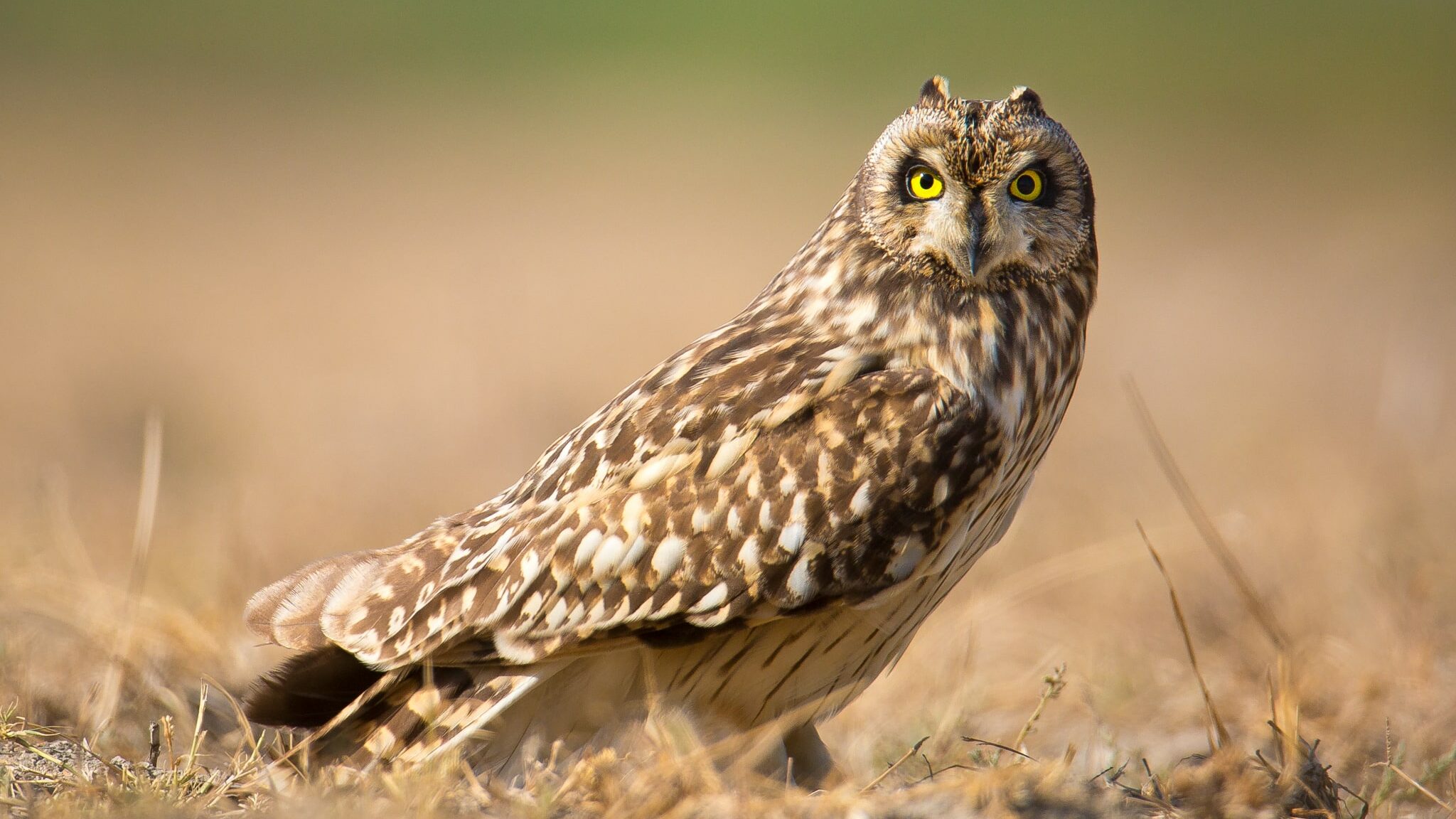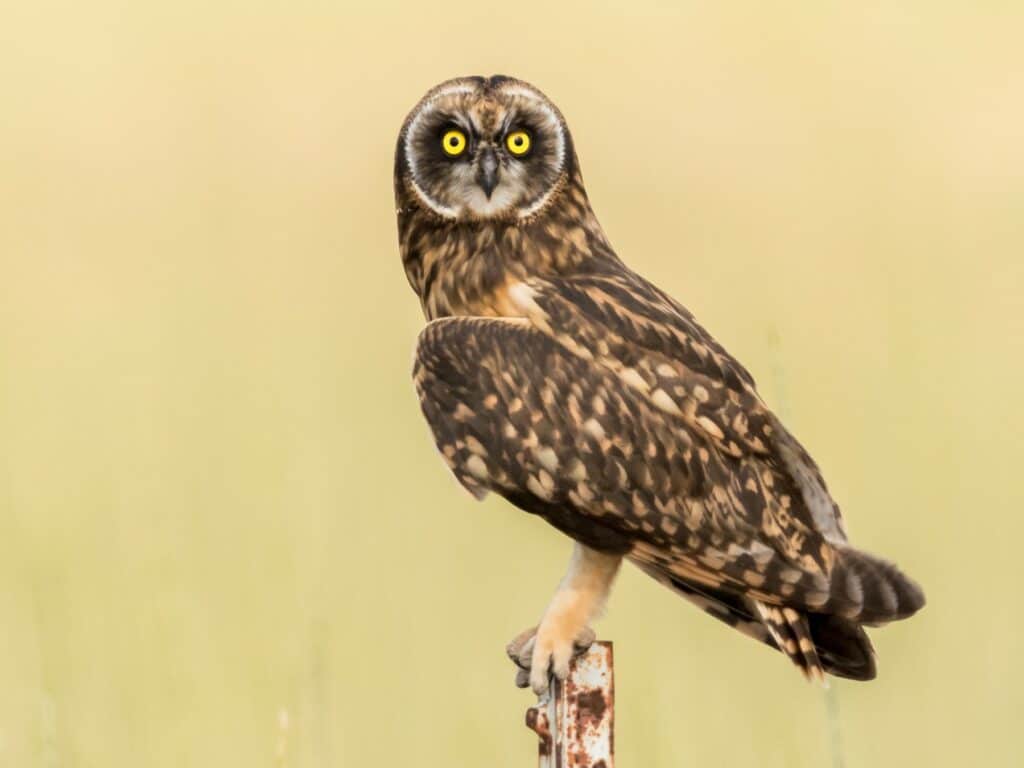The Short-Eared Owl (Asio flammeus) is a species of owl that is widely distributed across various habitats, including grasslands, tundra, and marshes. This article provides an objective and impersonal examination of the physical characteristics, behaviour, diet, breeding habits, migration patterns, conservation status, and interesting facts associated with this species.
Habitat and Distribution
The short-eared owl (asio flammeus) is known to inhabit a wide range of open habitats, including grasslands, marshes, tundra, and agricultural fields. It has a broad distribution across North America, Europe, Asia, and Africa. This species exhibits migratory behaviour in response to seasonal changes in food availability and weather conditions. Migration routes vary among populations but generally follow latitudinal or longitudinal patterns. The short-eared owl plays an important role in local ecosystems as both predator and prey. Its presence can regulate populations of small mammals such as voles and mice, which are primary food sources for the owls. Additionally, its hunting activity can influence vegetation dynamics by reducing grazing pressure from rodents on plant communities. Therefore, the short-eared owl’s migration routes have implications for both predator-prey interactions and ecosystem functioning within their respective habitats.
Physical Characteristics
Characterised by a facial disk, short wingspan, and distinct ear tufts, the short-eared owl (Asio flammeus) possesses unique physical characteristics. These adaptations enable it to excel in its flight patterns and hunting strategies. The facial disk acts as a sound collector, allowing the owl to locate prey accurately through enhanced hearing. Its short wingspan aids in manoeuvrability during flight, enabling it to navigate densely vegetated areas more efficiently than other owl species with longer wings. Additionally, the distinct ear tufts are not actually ears but serve as visual cues for communication and territorial displays rather than playing a role in auditory perception.

Behaviour and Hunting Techniques
Adapting to their environment, short-eared owls employ a variety of hunting techniques and display distinctive behaviours. As nocturnal hunters, they possess adaptations that enable effective hunting in low-light conditions. Short-eared owls are known for their versatile hunting methods, including aerial hunting and ground-based stalking. They have the ability to hover above open fields to spot prey and then swoop down with precision to catch it.
Additionally, these owls engage in social interactions during the breeding season, which may include courtship displays and territorial defence. During this time, males perform aerial displays, such as flying high and diving rapidly towards the ground while vocalising loudly. These behaviours are essential for establishing territories and attracting mates.
Diet and Feeding Habits
To sustain their energy demands, short-eared owls consume a diverse range of prey items, including small mammals, birds, and insects. Owl prey selection is influenced by various factors such as the availability and abundance of certain species in their habitat. Short-eared owls exhibit different hunting strategies depending on the type of prey they are targeting. When hunting for small mammals, they rely on their exceptional hearing to locate potential prey hidden in vegetation or beneath the snow. They then use their powerful wings to silently glide towards their target before swooping down for a successful capture.
In contrast, when hunting for birds or insects, short-eared owls demonstrate more agile flight patterns characterised by quick aerial manoeuvres and sudden dives to catch their prey mid-air. These versatile hunting strategies allow short-eared owls to adapt to different environments and secure a steady food supply.
Breeding and Reproduction
Breeding and reproduction in the short-eared owl (Asio flammeus) involves a complex series of behaviours and physiological changes that ensure successful mating and the production of healthy offspring. The breeding success of this species is influenced by various factors, including reproductive behaviour. Male short-eared owls engage in courtship displays to attract females, which may include vocalisations, wing waving, and aerial acrobatics. Once a pair forms, they engage in mutual preening and nest-building activities. Female owls lay a clutch of eggs in a nest on the ground or in a shallow depression. Incubation duties are shared between both parents, with the female typically incubating during the day and the male taking over at night. After hatching, both parents provide food for their young until they fledge and become independent.
Migration Patterns
Migration patterns in the short-eared owl population exhibit a remarkable ability to cover vast distances, with individuals traversing long migratory routes to reach their breeding and wintering grounds. These migration routes are essential for their survival as they allow the owls to access suitable habitats for breeding and find abundant food resources during the winter months. Short-eared owls undertake seasonal movements, with individuals leaving their breeding grounds in search of more favourable conditions elsewhere.
The specific paths taken by these birds vary depending on factors such as habitat availability, prey distribution, and weather conditions. Research has shown that some populations of short-eared owls migrate over long distances, often spanning several countries or continents. Understanding these migration patterns is crucial for conservation efforts aimed at protecting key stopover sites and ensuring the long-term survival of this species.

Surprising Owl Behaviour
Surprising behaviour exhibited by owls includes their ability to fly silently due to specialised feathers that reduce noise. This adaptation allows them to approach prey without detection. In addition to their silent flight, owls are known for their unique vocalisations. These vocalisations serve various purposes, such as establishing territory, attracting mates, and communicating with offspring. Owl calls can range from melodic hoots to screeches and hisses.
Another intriguing nocturnal adaptation of owls is their excellent night vision. Owls have large eyes that are well-adapted for seeing in low light conditions. Their eyes are equipped with a high number of light-sensitive cells called rods, which allow them to see in almost total darkness. Furthermore, the positioning of the owl’s eyes provides them with a wide field of binocular vision and superior depth perception, making them highly efficient hunters in the dark.

Interesting Facts and Folklore
Owl folklore spans across cultures, with many ancient civilizations associating these birds with wisdom, mystery, and even death. Exploring the various myths and legends surrounding owls provides insight into how they have been perceived throughout history.
Symbolic representations of the short-eared owl can be found in various cultures and belief systems, making it a captivating subject within the realm of owl folklore. The owl holds a prominent place in mythology and has cultural significance in many societies. For example, in ancient Greek mythology, owls were associated with Athena, the goddess of wisdom. They symbolised intelligence and knowledge. In Native American cultures, the short-eared owl was often seen as a messenger or omen. It was believed that hearing an owl’s call could foretell death or bring good fortune depending on the context. Similarly, in Celtic folklore, owls were considered guardians of the underworld and were thought to have magical powers.
Conclusion
In conclusion, the short-eared owl (asio flammeus) is a fascinating bird with unique characteristics and behaviours. It has a wide distribution across various habitats and is known for its distinctive physical features. The owl exhibits interesting hunting techniques and feeds primarily on small mammals and birds. Its breeding and reproductive patterns are intricately linked to its habitat and food availability. While it undergoes seasonal migrations, the conservation status of the species remains a concern. Overall, the short-eared owl holds an important place in both scientific studies and folklore traditions around the world.
Additional Resources
Sources and References
- Mikkola, H. (2012). Owls of the World: A Photographic Guide. Firefly Books.
- Taylor, M. (2014). The Owl: An Owl Book for the Owl-Minded. Bloomsbury Natural History.
- Toms, M. P. (2014). Owls. Bloomsbury Publishing.
Sam loves to learn about animals and their habitats. He has been a nature lover from a very young age, and has been writing papers and articles about wildlife for as long as he can remember.
